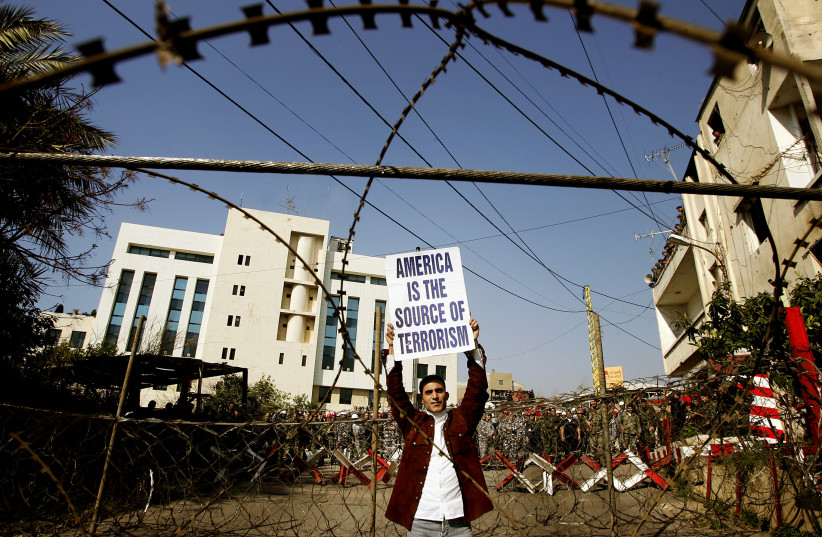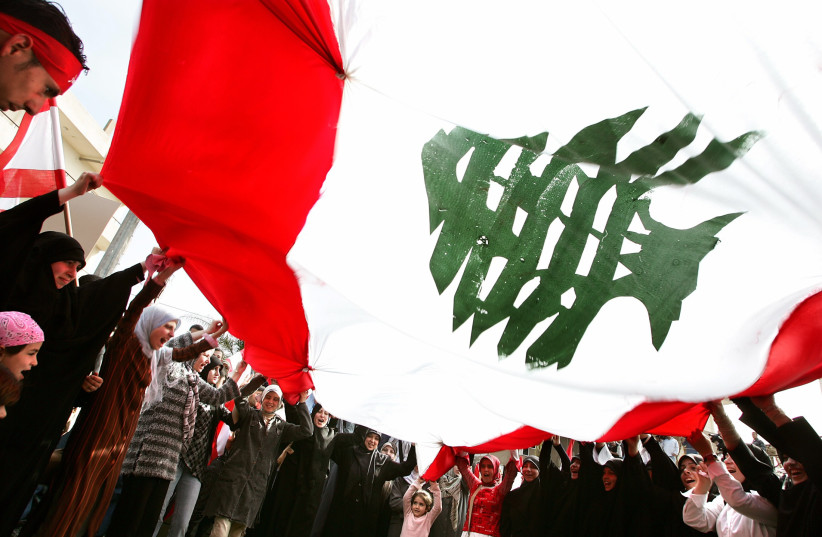Does this large embassy compound reflect 2023 thinking or thinking from the last decade?
By SETH J. FRANTZMAN
Updated: MAY 7, 2023

A Lebanese protester holds an anti-US banner behind razor wire during a protest in front of the US embassy near Beirut, March 15, 2005
(photo credit: REUTERS/DAMIR SAGOLJ/FILE PHOTO)
Photos posted on Twitter Friday by the US Embassy in Beirut showing the progress of construction on the new compound for the embassy have received an unusual amount of interest in the region and globally.
As of Saturday, there were some 1.5 million views of the photos and hundreds of comments, quoted tweets and bookmarks of the post. The reason is the photos show the huge mass of the new multi-building compound. The US has said it will sit on a 43-acre site. Other posts by the embassy get far fewer replies or interactions
Does US investment in Middle East illustrate its feelings on security?
The US has done this before in the region, investing in large embassy compounds. It has a large compound in Baghdad and the embassy in Kabul was built on 36 acres of land before Kabul fell to the Taliban. A new consulate in Erbil is also of massive size, sitting on some 50 acres of land. These are expensive projects too, running into the hundreds of millions and billions to build and maintain.
The decision to invest heavily in Beirut and Erbil would appear to illustrate where the US feels the future and security of the region are going. While in the 1980s, the US embassy was targeted in Beirut by terrorists, today the sense is that Beirut is a good choice. There aren’t a lot of other options. There is hostility to the US in Baghdad, generally driven by Iranian-backed militias.

Lebanese anti-US protesters wave a big Lebanese flag during a protest in front of the US embassy near Beirut, April 1, 2005
(credit: REUTERS/DAMIR SAGOLJ/FILE PHOTO)
What’s interesting about the photos of the Beirut compound construction is the replies it has received and the attention it is getting. This is because there are a lot of commentators who sense a shift in US policy in the region or are critical of the US. They see the images and they see a symbol...some of the comments wondered when the next “color revolution” would be set off in Lebanon.
Apparently, this is a reference to the US backing various pro-democracy revolutions in other places, but these “color” revolutions are also critiqued by those who see them as some kind of US conspiracy. Some comments wondered if the US would plant trees around the compound, which currently has a kind of brutalist feel to it. “Let them eat concrete,” one reply said.
Others had more comedic replies, such as wondering how many bags of Cheetos could fit in the massive compound. The quote tweets of the images included references to it looking like the “Death Star” from Star Wars. Another person wondered how the US could accuse Lebanon of being under Iranian influence if it was building such a massive compound.
Embassy construction sparks Israel conspiracy theories
Of course, some had the usual claims of the embassy somehow serving as a center for “spies” or being linked to US support for Israel. And then there were the cynics who wondered if the place has enough helicopter pads for when it needs to be evacuated as the US has evacuated diplomats in Kabul, Iraq, or Sudan.
The overall symbol of the massive investment in places like Beirut and Erbil is that the US is not withdrawing from the region, but it is shifting focus. It takes a long time to build an embassy or massive consulate on dozens of acres of land. One needs to find the land and set aside the funding in Washington. Then there are the inevitable cost overruns and construction delays. This means that from the point of deciding to do something, it might take 10 or 20 years.
That means the current investment in Beirut or Erbil was decided upon long ago at a different time when the region was different before it became normal to see the US as withdrawing and shifting priorities to deal with Russia and China. These compounds are the results of 2015 thinking when the US was involved in the war against ISIS and the Iran deal had just been concluded, and while Kabul was still safe.
It is worth considering that reality when thinking about whether this large embassy compound reflects 2023 thinking or thinking from the last decade. Either way, the US embassy has had its photos and post go viral.
What’s interesting about the photos of the Beirut compound construction is the replies it has received and the attention it is getting. This is because there are a lot of commentators who sense a shift in US policy in the region or are critical of the US. They see the images and they see a symbol...some of the comments wondered when the next “color revolution” would be set off in Lebanon.
Apparently, this is a reference to the US backing various pro-democracy revolutions in other places, but these “color” revolutions are also critiqued by those who see them as some kind of US conspiracy. Some comments wondered if the US would plant trees around the compound, which currently has a kind of brutalist feel to it. “Let them eat concrete,” one reply said.
Others had more comedic replies, such as wondering how many bags of Cheetos could fit in the massive compound. The quote tweets of the images included references to it looking like the “Death Star” from Star Wars. Another person wondered how the US could accuse Lebanon of being under Iranian influence if it was building such a massive compound.
Embassy construction sparks Israel conspiracy theories
Of course, some had the usual claims of the embassy somehow serving as a center for “spies” or being linked to US support for Israel. And then there were the cynics who wondered if the place has enough helicopter pads for when it needs to be evacuated as the US has evacuated diplomats in Kabul, Iraq, or Sudan.
That means the current investment in Beirut or Erbil was decided upon long ago at a different time when the region was different before it became normal to see the US as withdrawing and shifting priorities to deal with Russia and China. These compounds are the results of 2015 thinking when the US was involved in the war against ISIS and the Iran deal had just been concluded, and while Kabul was still safe.
It is worth considering that reality when thinking about whether this large embassy compound reflects 2023 thinking or thinking from the last decade. Either way, the US embassy has had its photos and post go viral.
No comments:
Post a Comment